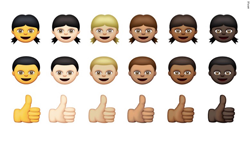The day has come when Apple released new emojis to the world. These new emojis have been speculated about, talked about and waited on for quite some time. Finally, the emojis have been released with the iOS 8.3 update.
The most important part about the emojis is their diversification and customization. With almost every emoji, you can now change their ethnicity. This gives the option of personalizing the character, as well as giving representation to multiple cultures.
Not only that, but it gives identity to some races that are not always represented equally in American society. Since my first iPhone, I’ve wondered why not all types of people were depicted in the iPhone emojis.
There has even been talk on social media about why there were not racially and culturally diverse emojis. There were some emojis that identified different cultures, but the standard emojis seemed to only be white.
With the new iOS 8.3 update, users can download a new emoji keyboard where you can select the emoji you would like to use, hold it down and change the ethnicity of that emoji. Once you have used that emoji, it can save as a preference in your “frequently used” bar.
Also, the default setting for emoji’s is no longer Caucasian, but is a yellow color, much like most emoticons use.
Chaeli Marinell, a junior communication student, said, “I got the iPhone update. I think that the new emojis are nice but strange because everything is yellow as a default. I like the variety though. It is weird that everything is in a different place.”
Athletics Professor-in-Residence and a professor of ethics, Claude Taylor, said, “In the study of media and technology, scholars often refer to popular culture as a “contested terrain”. Another way of saying this is that there are often struggles over respect and recognition in media spaces that to some people may seem simple, ordinary, or non-controversial. This is the case with emojis. People do look for reflections of themselves in the media they consume and create.”
Although Apple has now included the racially diverse emojis and same-sex families, you cannot change the race of emojis involving two or more people. Therefore, you cannot change the ethnicities of the family emojis. Marinelli stated, “I do think it is important that everyone is represented. It was kind of rude that wasn’t the standard in the first place.”
Amanda Kontor, a junior communication student, said, “Although I don’t have an iPhone, I would definitely choose to have the diverse emojis on it if I did. Having different cultures represented in something as small as the little icons people use on their phones sends a huge message.”
Although this update is not a large improvement on the representation of minorities in the media, Apple has increased the representation of all cultures with this update. It is important for any global entity much like Apple to include all cultures and ethnicities in their products, even if it is just emojis.
In a country that is so charged with racial issues being discussed in the media as well as the discussion of gender equality, Apple chose to update these emojis at the right time.
Even if this form of representation may have been a long time coming, at least it’s arrived.
Taylor said, “In terms of ethics, I see this as an egalitarian gesture, that is, an effort to be fair-minded and respectful in offering images for individuals to personalize their communication with others.”
Whether it is emoticons or something bigger, representation of multiple cultures is something American media organizations should achieve. Apple has just begun.
Hopefully, the next step is creating emojis that include diverse options for families. Apple’s inclusion of same-sex marriage couples in those emojis is a statement in itself, but this update could have included the option to change the ethnicities of those families.
Kontor said, “It’s a big step in the right direction, toward more inclusive and diversity-sensitive experiences for all. But there’s still more to be done.”
IMAGE TAKEN from Forbes



